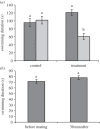The energetic cost of mating in a promiscuous cephalopod
- PMID: 22809722
- PMCID: PMC3441011
- DOI: 10.1098/rsbl.2012.0556
The energetic cost of mating in a promiscuous cephalopod
Abstract
Costs that individuals incur through mating can play an important role in understanding the evolution of life histories and senescence, particularly in promiscuous species. Copulation costs, ranging from energy expenditure to reduced longevity, are widely studied in insects but have received substantially less attention in other taxa. One cost of mating, the energetic cost, is poorly studied across all taxa despite its potential importance for the many species where copulation is physically demanding and/or frequent. Here, we investigated the energetic cost of mating in both male and female dumpling squid (Euprymna tasmanica). In this species, copulation can last up to 3 h and requires that the male physically restrains the female. We report that the act of copulation halves the swimming endurance of both sexes, and that they take up to 30 min to recover. Such a reduction in post-copulatory performance may have important implications for predator avoidance, foraging ability and energy allocation. Therefore, quantifying this cost is essential to understand the evolution of reproductive strategies and behaviours such as female receptivity and male and female mating frequency.
Figures


Similar articles
-
Does predation risk affect mating behavior? An experimental test in dumpling squid (Euprymna tasmanica).PLoS One. 2014 Dec 31;9(12):e115027. doi: 10.1371/journal.pone.0115027. eCollection 2014. PLoS One. 2014. PMID: 25551378 Free PMC article.
-
Single and multiple mating reduces longevity of female dumpling squid (Euprymna tasmanica).J Evol Biol. 2017 May;30(5):977-984. doi: 10.1111/jeb.13063. Epub 2017 Apr 5. J Evol Biol. 2017. PMID: 28278369
-
Multiple fitness benefits of polyandry in a cephalopod.PLoS One. 2012;7(5):e37074. doi: 10.1371/journal.pone.0037074. Epub 2012 May 16. PLoS One. 2012. PMID: 22615896 Free PMC article.
-
An integrative view of sexual selection in Tribolium flour beetles.Biol Rev Camb Philos Soc. 2008 May;83(2):151-71. doi: 10.1111/j.1469-185X.2008.00037.x. Biol Rev Camb Philos Soc. 2008. PMID: 18429767 Review.
-
Mating induces developmental changes in the insect female reproductive tract.Curr Opin Insect Sci. 2016 Feb;13:106-113. doi: 10.1016/j.cois.2016.03.002. Epub 2016 Mar 11. Curr Opin Insect Sci. 2016. PMID: 27436559 Review.
Cited by
-
Sperm depletion in relation to developmental nutrition and genotype in Drosophila melanogaster.Evolution. 2021 Nov;75(11):2830-2841. doi: 10.1111/evo.14373. Epub 2021 Oct 19. Evolution. 2021. PMID: 34617270 Free PMC article.
-
Rare polyandry and common monogamy in the firefly squid, Watasenia scintillans.Sci Rep. 2020 Jul 3;10(1):10962. doi: 10.1038/s41598-020-68006-1. Sci Rep. 2020. PMID: 32620906 Free PMC article.
-
Tactical Tentacles: New Insights on the Processes of Sexual Selection Among the Cephalopoda.Front Physiol. 2019 Aug 21;10:1035. doi: 10.3389/fphys.2019.01035. eCollection 2019. Front Physiol. 2019. PMID: 31496951 Free PMC article. Review.
-
When does female multiple mating evolve to adjust inbreeding? Effects of inbreeding depression, direct costs, mating constraints, and polyandry as a threshold trait.Evolution. 2016 Sep;70(9):1927-43. doi: 10.1111/evo.13005. Epub 2016 Aug 21. Evolution. 2016. PMID: 27464756 Free PMC article.
-
Female multiple matings and male harassment and their effects on fitness of arrhenotokous Thrips tabaci (Thysanoptera: Thripidae).Behav Ecol Sociobiol. 2015;69(10):1585-1595. doi: 10.1007/s00265-015-1970-5. Epub 2015 Jul 18. Behav Ecol Sociobiol. 2015. PMID: 26379364 Free PMC article.
References
-
- Le Boeuf B. J., Mesnick S. 1991. Sexual behavior of male northern elephant seals. I. Lethal injuries to adult females. Behaviour 116, 143–16210.1163/156853990×00400 (doi:10.1163/156853990×00400) - DOI - DOI
-
- Chapman T., Liddle L. F., Kalb J. M., Wolfner M. F., Partridge L. 1995. Cost of mating in Drosophila melanogaster females is mediated by male accessory gland products. Nature 373, 241–24410.1038/373241a0 (doi:10.1038/373241a0) - DOI - DOI - PubMed
-
- Elgar M. A., Schneider J. M. 2004. Evolutionary significance of sexual cannibalism. In Advances in the study of behavior (ed. Slater P. J. B.), pp. 135–163 London, UK: Academic Press
-
- Rose M. R. 1984. Laboratory evolution of postponed senescence in Drosophila melanogaster. Evolution 38, 1004–101010.2307/2408434 (doi:10.2307/2408434) - DOI - DOI - PubMed
-
- Partridge L. 1987. Is accelerated senescence a cost of reproduction? Funct. Ecol. 1, 317–32010.2307/2389786 (doi:10.2307/2389786) - DOI - DOI
Publication types
MeSH terms
LinkOut - more resources
Full Text Sources


